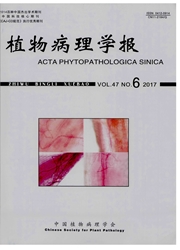

 中文摘要:
中文摘要:
本文针对香蕉枯萎病菌4号生理小种这一对我国香蕉生产构成了极大威胁的检疫性有害生物,建立了根癌农杆菌介导的该生理小种的转化体系,确定了影响转化效率主要因子的最佳条件分别是:共培养乙酰丁香酮(AS)浓度为200μmol/L、共培养时间为48h、培养温度为25℃、诱导培养基pH值为5.5。此条件下,转化效率达到21~24个转化子/10^4香蕉枯萎病菌孢子。PCR和Southern杂交分析表明外源的T.DNA已经成功随机地整合到该病原菌基因组中,且多为单拷贝。应用该转化体系已获得近25000个转化子,为研究该生理小种致病机制奠定了基础。
 英文摘要:
英文摘要:
Fusarium oxysporum f. sp. cubense (FOC) race 4, the quarantine fungus caused a highly destructive vascular wilt disease of banana, had been transformed by using Agrobacterium tumefaciens-mediated trans- formation. The objective of the study was to optimize the transformation system to obtain T-DNA inserted-mutants for gene functional study. The key conditions included co-cultivation with 200μmol/L acetosyringone for 48 h, induction cultivation at pH 5.5 and 25℃. Under the conditions, transformation efficiency was in the range of 21 -24 transformants per 104 FOC race 4 conidia. PCR and Southern blot analysis of the transformants showed that the T-DNA had been successfully integrated into genome of the fungus with the majority of single copy at random sites. A total of 25 000 transformants had been obtained in the study, which provided a foundation for better understuding molecular mechanism of FOC pathogenicity.
 同期刊论文项目
同期刊论文项目
 同项目期刊论文
同项目期刊论文
 期刊信息
期刊信息
